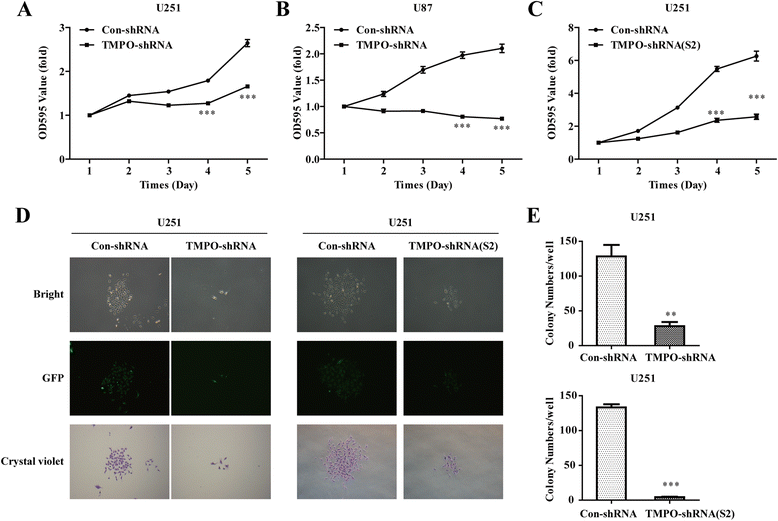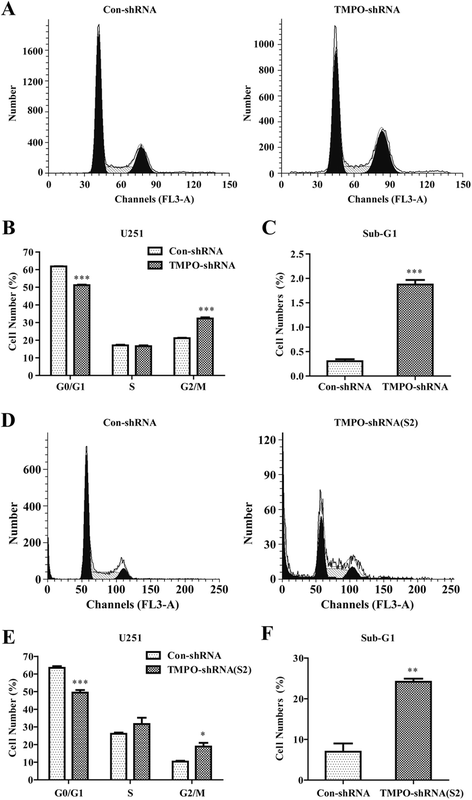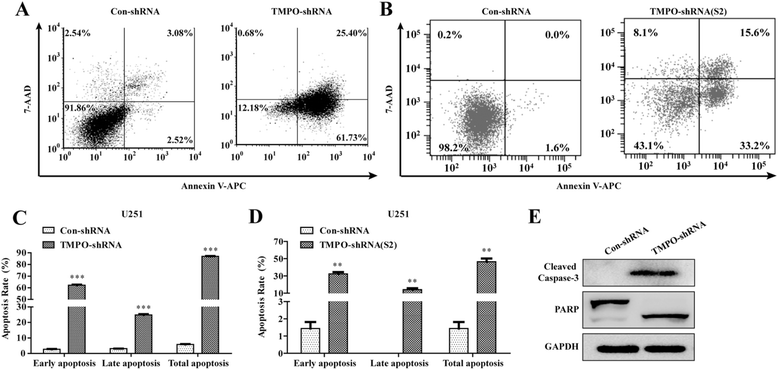Depletion of thymopoietin inhibits proliferation and induces cell cycle arrest/apoptosis in glioblastoma cells
- PMID: 27756319
- PMCID: PMC5069786
- DOI: 10.1186/s12957-016-1018-y
Depletion of thymopoietin inhibits proliferation and induces cell cycle arrest/apoptosis in glioblastoma cells
Abstract
Background: Glioblastoma (GBM) is the most malignant nervous system tumor with an almost 100 % recurrence rate. Thymopoietin (TMPO) has been demonstrated to be upregulated in various tumors, including lung cancer, breast cancer, and so on, but its role in GBM has not been reported. This study was aimed to determine the role of TMPO in GBM.
Methods: Publicly available Oncomine dataset analysis was used to explore the expression level of TMPO in GBM specimens. Then the expression of TMPO was knocked down in GBM cells using lentiviral system, and the knockdown efficacy was further validated by real-time quantitative PCR and western blot analysis. Furthermore, the effects of TMPO silencing on GBM cell proliferation and apoptosis were examined by MTT, colony formation, and flow cytometry analysis. Meanwhile, the expression of apoptotic markers caspase-3 and poly(ADP-ribose) polymerase (PARP) were investigated by western blot analysis.
Results: This study observed that the expression of TMPO in GBM specimens was remarkably higher than that in normal brain specimens. Moreover, knockdown of TMPO could significantly inhibit cell proliferation and arrest cell cycle progression at the G2/M phase. It also found that TMPO knockdown promoted cell apoptosis by upregulation of the cleavage of caspase-3 and PARP protein levels which are the markers of apoptosis.
Conclusions: The results suggested TMPO might be a novel therapeutic target for GBM.
Keywords: Apoptosis; Cell proliferation; Glioblastoma; TMPO.
Figures





Similar articles
-
[Proliferation inhibition and apoptosis promotion induced by deletion of TMPO in A549].Zhonghua Zhong Liu Za Zhi. 2019 Oct 23;41(10):742-747. doi: 10.3760/cma.j.issn.0253-3766.2019.10.004. Zhonghua Zhong Liu Za Zhi. 2019. PMID: 31648495 Chinese.
-
Knockdown of ribosomal protein S15A induces human glioblastoma cell apoptosis.World J Surg Oncol. 2016 Apr 29;14:129. doi: 10.1186/s12957-016-0891-8. World J Surg Oncol. 2016. PMID: 27130037 Free PMC article.
-
PARP inhibition restores extrinsic apoptotic sensitivity in glioblastoma.PLoS One. 2014 Dec 22;9(12):e114583. doi: 10.1371/journal.pone.0114583. eCollection 2014. PLoS One. 2014. PMID: 25531448 Free PMC article.
-
The Emerging Role of Thymopoietin-Antisense RNA 1 as Long Noncoding RNA in the Pathogenesis of Human Cancers.DNA Cell Biol. 2021 Jul;40(7):848-857. doi: 10.1089/dna.2021.0024. Epub 2021 Jun 4. DNA Cell Biol. 2021. PMID: 34096793 Review.
-
The Unexpected Roles of Aurora A Kinase in Gliobastoma Recurrences.Target Oncol. 2017 Feb;12(1):11-18. doi: 10.1007/s11523-016-0457-2. Target Oncol. 2017. PMID: 27573024 Review.
Cited by
-
Epigenetic Profiling of Curcumin on Histone Signatures in Breast Cancer using 3D Network.bioRxiv [Preprint]. 2025 May 7:2024.11.13.623008. doi: 10.1101/2024.11.13.623008. bioRxiv. 2025. PMID: 40654641 Free PMC article. Preprint.
-
Prognostic significance and biological function of Lamina-associated polypeptide 2 in non-small-cell lung cancer.Onco Targets Ther. 2019 May 16;12:3817-3827. doi: 10.2147/OTT.S179870. eCollection 2019. Onco Targets Ther. 2019. PMID: 31190881 Free PMC article.
-
The expression and role of the Lem-D proteins Ankle2, Emerin, Lemd2, and TMPO in triple-negative breast cancer cell growth.Front Oncol. 2024 Apr 24;14:1222698. doi: 10.3389/fonc.2024.1222698. eCollection 2024. Front Oncol. 2024. PMID: 38720803 Free PMC article.
-
Thymus-derived hormonal and cellular control of cancer.Front Endocrinol (Lausanne). 2023 Jul 17;14:1168186. doi: 10.3389/fendo.2023.1168186. eCollection 2023. Front Endocrinol (Lausanne). 2023. PMID: 37529610 Free PMC article. Review.
-
Identification of lncRNAs involved in response to ionizing radiation in fibroblasts of long-term survivors of childhood cancer and cancer-free controls.Front Oncol. 2023 Apr 27;13:1158176. doi: 10.3389/fonc.2023.1158176. eCollection 2023. Front Oncol. 2023. PMID: 37182169 Free PMC article.
References
MeSH terms
Substances
LinkOut - more resources
Full Text Sources
Other Literature Sources
Medical
Research Materials
Miscellaneous

